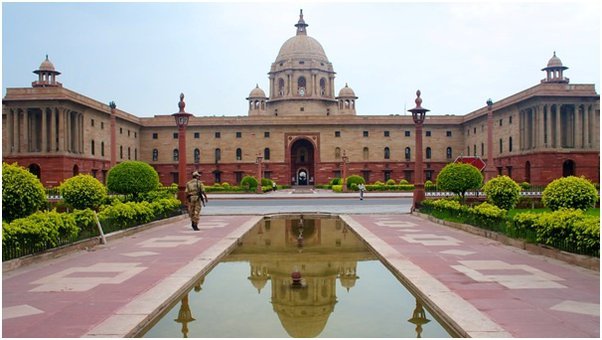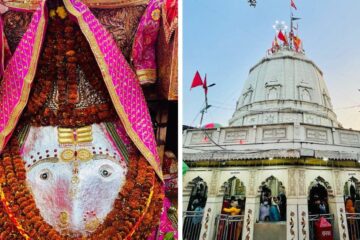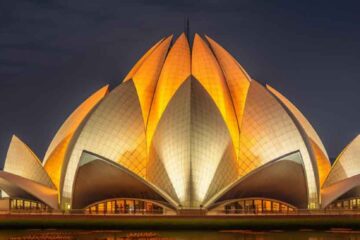Rashtrapati Bhavan

The Honorable President of India resides in Rashtrapati Bhavan in New Delhi. The structure, sometimes called Rashtrapati Bhavan or Rashtrapati Nivas, is one of the largest and most grandiose residences ever built for a head of state in the world. The huge mansion itself, with the vast gardens spread around it, is one of the most popular tourist destinations in New Delhi. After leaving your Delhi hotel for some sightseeing, how about visiting the presidential residence of the world’s largest democracy?
We provide you all the information you need about Rashtrapati Bhavan in New Delhi in this blog, including information about its history, architecture, hours, entry price, information for visitors and other fascinating facts.
Rashtrapati Bhavan: Information
| Location | Rajpath, New Delhi |
| Type | Official Residence |
| Also Known as | President House, Presidential Residence |
| Formerly Known as | Viceroy’s House |
| Timings | 9:00 am to 4:00 pm; prior permission and booking required |
| Entry Fee | ₹50 per person per circuit (for individuals or a group of fewer than 30 people) |
| ₹1200 per person (for a group of 30 people) | |
| ₹1200 per person + ₹50 per additional visitor (for a group of more than 30 people) | |
| There are no charges for visitors below 8 years of age | |
| Circuits and Timings | Circuit 1: Central Lawn and Main Building (Thursday to Sunday) |
| Circuit 2: Rashtrapati Bhavan Museum Complex (RBMC) (Closed on Mondays) | |
| Circuit 3: Gardens (Thursday to Sunday; from August to March) | |
| All circuits are closed on gazetted holidays | |
| Change of Guard Ceremony | Saturdays and Sundays |
| Timings of Change of Guard Ceremony | Saturdays, 8:00 am to 8:40 am (15 March to 14 November) |
| 10:00 am to 10:40 am (15 November to 14 March) | |
| Sundays, 5:30 pm to 6:10 pm (15 March to 14 November) | |
| 4:30 pm to 5:10 pm (15 November to 14 March) | |
| Architectural Style | A blend of classical European and Indian architectural styles |
| Architects | Sir Edwin Lutyens and Herbert Baker |
| Construction Period | 1911 to 1929 |
| Area | 321 acres |
| Floor Area | 2,00,000 sq. ft. |
| First Occupant | Lord Irwin |
| Current Occupant | Ram Nath Kovind, the current President of India |
| Cost of Construction | 14 million Indian rupees |
| Nearest Metro Station | Central Secretariat (on the Yellow/Violet Line) |
| Online Booking (Rashtrapati Bhavan) | http://rashtrapatisachivalaya.gov.in/rbtour/ |
| Online Booking (Change of Guard) | https://rb.nic.in/rbvisit/visit_plan.aspx |
Rashtrapati Bhavan: History
After the transfer of the capital of British India from Calcutta to Delhi in 1911, it became necessary to build a new house for the Viceroy of India. British architect Sir Edwin Landseer Lutyens was entrusted with the task of creating the future capital city as well as the layout of Delhi’s viceroy’s mansion.
About 4,000 acres of land were purchased on Raisina Hill. Under the direction of Lutyens and his project partner, Herbert Baker, construction of the grand mansion began in 1911. Construction was delayed due to World War I, but it was originally scheduled to be completed in four years.
After almost 17 years, at an estimated cost of 14 million Indian rupees, the house was finally completed in 1929. About 23,000 workers were involved in its construction, and Lord Irwin, the Viceroy and Governor General of India at the time, laid the final stone. By the way, on April 6, 1929, he came to this brand new house for the first time.
Initially known as the Viceroy’s House, the building represented the residence and royal dominions of the Viceroy of India. After India gained independence in 1947, the building was named Government House. After Chakraborty Rajagopalachari was appointed as the first Governor General of post-independence India, he became the first Indian to reside in it.
Rashtrapati Bhavan, also known as Rashtrapati Bhavan, was given the new name on January 26, 1950, when Rajendra Prasad took office as the first President of India. The complex was made accessible to the public in August 2012, thanks to the efforts of then-President Pranab Mukherjee.
Rashtrapati Bhavan: Architecture
The huge, four-story building of Rashtrapati Bhavan is situated on a vast site spread over 321 acres. The main structure houses the President’s official home, a library, a ballroom, guest rooms, reception rooms, and offices, among the 340 rooms.
The house was constructed using elements of Indian architecture in addition to traditional European design. The building is decorated with many traditional Indian themes, including royal elephants, circular stone basins, and red sandstone jaalis that display paintings from Rajasthan. Another distinctive aspect of the building’s design is the inclusion of Indian temple bells on the pillars.
This H-shaped skyscraper has a floor space of over 200,000 square feet. Its construction required an estimated 700 million bricks and approximately 3 million cubic feet of stone. You might be surprised to know that the entire construction was done with very little steel.
The central dome of Rashtrapati Bhavan is one of its most notable features. Its dome, which is twice the height of the building and on which the national flag is flying, is visible even from a distance. While Lutyens, the principal architect of the Rashtrapati Bhavan, acknowledged the influence of the Pantheon in Rome on the shape of the dome, other academics have also discovered similarities between the dome and the Great Stupa at Sanchi, an ancient Buddhist monument in central India.
The Mughal Gardens, Rashtrapati Bhavan
Known as the Mughal Gardens, the expansive presidential garden is one of Rashtrapati Bhavan’s most striking attractions. This 15-acre park was inspired by miniature paintings from Persia and India, the Mughal Gardens in Jammu and Kashmir, and the gardens of the Taj Mahal.
This garden is home to a wide variety of flowering plants, including 159 kinds of roses. It is appropriate to refer to this garden as Rashtrapati Bhavan’s soul. Every year, during Udyanotsav, which takes place here in February or March, the garden is available to the public.
Rashtrapati Bhavan Museum
Pranab Mukherjee opened the museum to the public on the grounds of Rashtrapati Bhavan in July 2014. It gives you insight into the building’s past, including artwork, interior design, architectural features, and the lives of the presidents who lived in it.
Rashtrapati Bhavan: Today
Topping the list of the greatest historical places to visit in Delhi is Rashtrapati Bhavan, which is also the current home of Indian President Ram Nath Kovind. Since independence, the building has been the venue of many important occasions, such as the swearing-in of officers, defense investiture ceremonies, recognition of courageous souls and achievers in their fields, the signing of treaties and contracts, and celebrations of national holidays. Celebrate.
Things to See in the Rashtrapati Bhavan Complex
Rashtrapati Bhavan is a large complex that is home to a variety of attractive buildings and activities. Depending on the circuit you choose, you can check the following options:
Circuit 1 (Central Lawn & Main Building):
- Forecourt
- Central Lawn
- Central Dome
- Banquet Hall
- Durbar Hall
- Library
- North Drawing Room
- Ashok Hall
- Navachara
- Long Drawing Room
- Iron Gate
- Tuscan Pillars
- Jaipur Column
Circuit 2 (Museum):
- The Clock Tower
- The Stables
- The Garages
Circuit 3 (Gardens)
- Mughal Gardens
- Herbal Garden
- Musical Garden
- Spiritual Garden
Lesser-known facts about Rashtrapati Bhavan, New Delhi
- Rashtrapati Bhavan is a large complex, built in various ways. The 145-foot-tall Jaipur Pillar was donated by the Maharaja of Jaipur, Sawai Madho Singh, in honor of Delhi being designated as the new capital of India, which is located inside the forecourt.
- There are no windows on the front of Rashtrapati Bhavan.
- Chakravarti Rajagopalachari thought that the residential wing of the structure was too opulent for his modest tastes, so he chose to live in the guest wing. He converted the residential wing into a guest wing, which served as host to heads of state of various countries. Since then, it has been accepted as standard by every other building resident.
- The roses in the Mughal Gardens are named after national and international personalities and celebrities, including Mr. Lincoln, Christian Dior, Jawahar, Queen Elizabeth, Raja Ram Mohan Roy, and Mother Teresa. It is home to attractive buildings and activities. Depending on the circuit you choose, you can check the following options:
- Seven hundred people are employed in the building.
- Sahastrabahu Avalokiteshvara, the 1000-armed statue of Lord Buddha, is located in Rashtrapati Bhavan. It was a gift from the Vietnamese government to Dr. Sarvepalli Radhakrishnan, the second President of India.
- The library of Rashtrapati Bhavan is named The Daughter of the Durbar Hall.
Attractions near Rashtrapati Bhavan
- Gurdwara Rakab Ganj Sahib (1 km)
- National Museum (1.5 km)
- Nehru Planetarium (1.8 km)
- Teen Murti Bhavan (1.9 km)
- Gandhi Smriti (2 km)
- Gurudwara Bangla Sahib (2.5 km)
- India Gate (2.9 km)
- Jantar Mantar (3.2 km)
- Humayun’s Tomb (6.9 km)
- Jama Masjid (7.4 km)
- Red Fort (7.8 km)
After gaining extensive knowledge about Rashtrapati Bhavan, aren’t you curious to see this magnificent mansion? So feel free to step inside and enjoy the architectural splendor and grandeur of one of the largest presidential palaces in the world.



1 Comment
2 Days Delhi Itinerary: A Perfect Plan for Sightseeing · June 16, 2024 at 3:48 pm
[…] Rashtrapati Bhawan […]